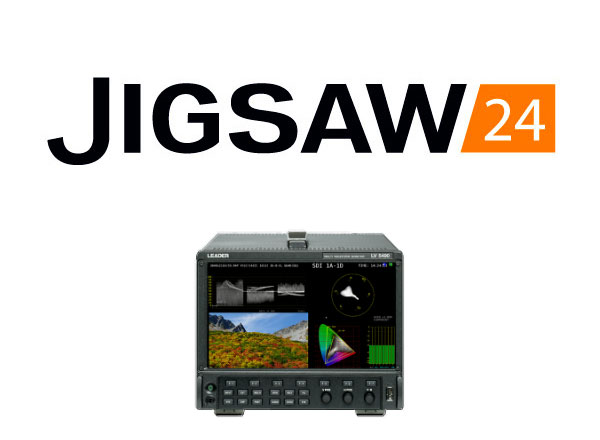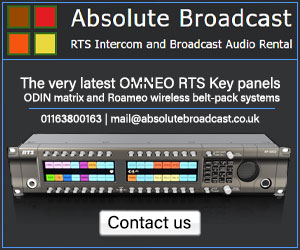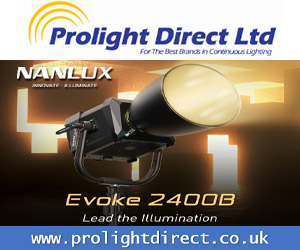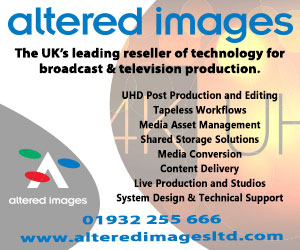Broadcast News
20/03/2018
How Long Can Your HDR Workflow Wait?

Unlike the move from SD to HD and from HD to 4K, the move to HDR isn't going to have a huge impact on your data rate or infrastructure. However, there are key changes that need to be made during production, post and delivery and, unsurprisingly, they come with quite a price tag.
Understandably, people want to hold off on investing in HDR-capable equipment until they've booked a job that demands an HDR deliverable. But waiting until you've signed a contract is risky, as it leaves you with a very limited window in which to develop a workflow, find and install equipment – which employees may or may not be comfortable with – and get to grips with the broadcaster's requirements for acquisition and delivery.
So, what can you do to prepare without paying too much upfront?
Shooting log for SDR versus HDR
"The most obvious and expensive change in production is that you'll need to use HDR-capable cameras," said our systems integration engineer, Phil Crawley. "But you may well have some already – HDR-capable cameras have been around for a while now, it's just that people have been using log-type gammas to give the colourist some extra latitude in the grade, rather than because they have to create an HDR deliverable."
You will, however, need to overhaul your monitoring setup. Your DOP and/or racks engineer is going to need to start monitoring in SDR and HDR to ensure that the image you capture works in both standard and high dynamic range. Keep an eye out for cables that are hidden in shadow in SDR footage but visible in HDR, windows that are blown out in SDR not HDR, and costume jewellery that's shiny in SDR but a dazzling, distracting highlight in HDR.
"A lot of details that are hidden in SDR become visible when you do a good HDR pass on an image," M&E systems developer, Jamie Allan said. "You want to be able to monitor where your luminance levels are outside SDR space on set, partly so your image can look as good as possible, but also because it may be that you need to change things practically – if you can see part of a lighting rig in the HDR image, you need to find a different way to light the scene or be prepared to pay to add VFX to the shot."
"Having a lighting camera operator or a lighting director who's worked with HDR before is ideal," Phil added. "And you need to think carefully about your camera operators if you're shooting something fast and unscripted, like reality television. With SDR cameras, if you had a decent auto focus and auto iris, you could have the runner shooting the B roll and it would look usable. That's not the case if you want good looking HDR pictures."
Key equipment pick: Atomos Sumo monitor-recorder
Sumo's 19" 1920×1080 10-bit LCD panel is driven by the AtomHDR engine, which precisely maps the Log/PQ/HLG from popular cameras, game consoles or TV makers to perfectly resolve 10+ stops of HDR in real time. View scenes on the monitor itself, or output to larger HDR/Rec. 709 displays for on set review. The Sumo can also be used with popular editing and grading suites in the studio or as part of your onset workflow.
Developing your post workflow
"Resolve, Baselight and Nucoda have all been able to handle HDR for about a year now, so again your investment is going to be in monitors and scopes," says Phil. "If you want a quality HDR mastering display at the moment, you've only got three choices and they'll all require a sizeable budget."
Those choices would be: the Sony BVM-X300, Netflix's currently preferred monitor; Canon's DP-V3010 and EIZO's new challenger, the CG3145 (this hugely impressed us when we had it in the office, and we strongly recommend you book some time with our demo model).
You'll also need LEADER's scopes – other HDR waveform monitors are available, but they're pretty primitive and LEADER's are the only ones we'd recommend spending money on, and our customers so far have agreed. (Representative quote from Daniel Sassen, Head of Technical Operations at ENVY Post Production: "With high-end productions moving to UHD/4K and HDR delivery we found the LV5490 to be an excellent tool for our colourists to accurately monitor which parts of the picture are really showing off the highlights and extended colour range that comes with UHD.")
The temptation may be to wait and see if the cost of HDR monitoring falls at all, but this seems unlikely in the short term, and by not planning for HDR work ahead of time, you run the risk of falling foul of "nuances and little gotchas between different gammas that mean you have to make different decisions based on what you have to deliver," according to Jamie.
"Even if you're not going out and buying kit, you need to be investing in workflow development and intelligence, so that when a job does come in, nothing takes you by surprise. This is more complicated than going from HD to 4K and you need to empower yourself to talk about it confidently with production companies and clients. At the bare minimum, get out there with demo units, research the kit and design a workflow that you're confident you can implement when work comes in.
"The more you understand the entire end to end process of delivering to a broadcaster or OTT provider, the better you can inform production companies who are developing their workflows, the better service your engineers and operators are going to be able to provide, and the more likely you are to win repeat business."
Rather than hold off altogether, a better move is to invest in one HDR-ready room for your online, and then do your offline with SDR proxies, which will work just fine with your existing monitors and equipment.
Delivery and QC
Broadcasters and OTT providers are requesting their HDR content in different formats, and passing QC for all of them is another of those areas of your HDR workflow which is going to be more complex than you thought. Again, it's worth putting the hours in beforehand, as the consequences of failing can be severe: Netflix, one of the biggest sources of HDR jobs, blacklist companies whose first-time pass rate falls below a certain point.
Key equipment pick: LEADER waveform monitors
The broadcasters you're delivering to use these for QC, so the easiest way to ensure you'll pass is to invest in the same. They're a welcome addition at any point in your workflow – they were used for the latest series of The Grand Tour and were apparently the only change to equipment in the show's history that operators didn't complain about, while colourists doing SDR and HDR passes will appreciate the Cinezone false colour display that highlights the parts of the image that are in HDR.
Make your own business
Ultimately, preparing for HDR work may be the fastest way to book it. "We're at the point where a lot of broadcasters are watching the development of HDR very closely, even if they're not yet asking for it as a deliverable," Jamie said. "If you're bidding for high-end work and can't competently deliver it in HDR, even if that's not what's being asked for yet, you may find yourself getting passed over for future work.
"A lot of productions are asking for an SDR and an HDR version, so that they have the HDR version ready for the future, however it pans out. If you're in a position to talk to production companies or broadcasters about the options these new formats and colour spaces give them, and it could impact or improve their distribution deals, you're far more likely to get clients asking for an HDR deliverable, and secure work to pay off your initial investment faster."
And, when the job arrives and it's time for you to either buy the kit you've been testing or complete your setup, give us a call. We have a team of experts who can advise on your HDR workflow, yes, but we also have a massive stockholding, so are the most likely to have niche kit in stock – otherwise, lead times for new HDR kit can run to weeks. We've also got a ready supply of demo units that we're happy to loan out as stopgap solutions while you're waiting for kit to arrive, and can even provide training on how to manage HDR on set.
To demo any of the kit discussed here, or speak to one of our workflow design specialists, give us a call on 03332 409 306 or email [email protected]. For all the latest news, follow @WeAreJigsaw24 on Twitter, or 'Like' us on Facebook.
Understandably, people want to hold off on investing in HDR-capable equipment until they've booked a job that demands an HDR deliverable. But waiting until you've signed a contract is risky, as it leaves you with a very limited window in which to develop a workflow, find and install equipment – which employees may or may not be comfortable with – and get to grips with the broadcaster's requirements for acquisition and delivery.
So, what can you do to prepare without paying too much upfront?
Shooting log for SDR versus HDR
"The most obvious and expensive change in production is that you'll need to use HDR-capable cameras," said our systems integration engineer, Phil Crawley. "But you may well have some already – HDR-capable cameras have been around for a while now, it's just that people have been using log-type gammas to give the colourist some extra latitude in the grade, rather than because they have to create an HDR deliverable."
You will, however, need to overhaul your monitoring setup. Your DOP and/or racks engineer is going to need to start monitoring in SDR and HDR to ensure that the image you capture works in both standard and high dynamic range. Keep an eye out for cables that are hidden in shadow in SDR footage but visible in HDR, windows that are blown out in SDR not HDR, and costume jewellery that's shiny in SDR but a dazzling, distracting highlight in HDR.
"A lot of details that are hidden in SDR become visible when you do a good HDR pass on an image," M&E systems developer, Jamie Allan said. "You want to be able to monitor where your luminance levels are outside SDR space on set, partly so your image can look as good as possible, but also because it may be that you need to change things practically – if you can see part of a lighting rig in the HDR image, you need to find a different way to light the scene or be prepared to pay to add VFX to the shot."
"Having a lighting camera operator or a lighting director who's worked with HDR before is ideal," Phil added. "And you need to think carefully about your camera operators if you're shooting something fast and unscripted, like reality television. With SDR cameras, if you had a decent auto focus and auto iris, you could have the runner shooting the B roll and it would look usable. That's not the case if you want good looking HDR pictures."
Key equipment pick: Atomos Sumo monitor-recorder
Sumo's 19" 1920×1080 10-bit LCD panel is driven by the AtomHDR engine, which precisely maps the Log/PQ/HLG from popular cameras, game consoles or TV makers to perfectly resolve 10+ stops of HDR in real time. View scenes on the monitor itself, or output to larger HDR/Rec. 709 displays for on set review. The Sumo can also be used with popular editing and grading suites in the studio or as part of your onset workflow.
Developing your post workflow
"Resolve, Baselight and Nucoda have all been able to handle HDR for about a year now, so again your investment is going to be in monitors and scopes," says Phil. "If you want a quality HDR mastering display at the moment, you've only got three choices and they'll all require a sizeable budget."
Those choices would be: the Sony BVM-X300, Netflix's currently preferred monitor; Canon's DP-V3010 and EIZO's new challenger, the CG3145 (this hugely impressed us when we had it in the office, and we strongly recommend you book some time with our demo model).
You'll also need LEADER's scopes – other HDR waveform monitors are available, but they're pretty primitive and LEADER's are the only ones we'd recommend spending money on, and our customers so far have agreed. (Representative quote from Daniel Sassen, Head of Technical Operations at ENVY Post Production: "With high-end productions moving to UHD/4K and HDR delivery we found the LV5490 to be an excellent tool for our colourists to accurately monitor which parts of the picture are really showing off the highlights and extended colour range that comes with UHD.")
The temptation may be to wait and see if the cost of HDR monitoring falls at all, but this seems unlikely in the short term, and by not planning for HDR work ahead of time, you run the risk of falling foul of "nuances and little gotchas between different gammas that mean you have to make different decisions based on what you have to deliver," according to Jamie.
"Even if you're not going out and buying kit, you need to be investing in workflow development and intelligence, so that when a job does come in, nothing takes you by surprise. This is more complicated than going from HD to 4K and you need to empower yourself to talk about it confidently with production companies and clients. At the bare minimum, get out there with demo units, research the kit and design a workflow that you're confident you can implement when work comes in.
"The more you understand the entire end to end process of delivering to a broadcaster or OTT provider, the better you can inform production companies who are developing their workflows, the better service your engineers and operators are going to be able to provide, and the more likely you are to win repeat business."
Rather than hold off altogether, a better move is to invest in one HDR-ready room for your online, and then do your offline with SDR proxies, which will work just fine with your existing monitors and equipment.
Delivery and QC
Broadcasters and OTT providers are requesting their HDR content in different formats, and passing QC for all of them is another of those areas of your HDR workflow which is going to be more complex than you thought. Again, it's worth putting the hours in beforehand, as the consequences of failing can be severe: Netflix, one of the biggest sources of HDR jobs, blacklist companies whose first-time pass rate falls below a certain point.
Key equipment pick: LEADER waveform monitors
The broadcasters you're delivering to use these for QC, so the easiest way to ensure you'll pass is to invest in the same. They're a welcome addition at any point in your workflow – they were used for the latest series of The Grand Tour and were apparently the only change to equipment in the show's history that operators didn't complain about, while colourists doing SDR and HDR passes will appreciate the Cinezone false colour display that highlights the parts of the image that are in HDR.
Make your own business
Ultimately, preparing for HDR work may be the fastest way to book it. "We're at the point where a lot of broadcasters are watching the development of HDR very closely, even if they're not yet asking for it as a deliverable," Jamie said. "If you're bidding for high-end work and can't competently deliver it in HDR, even if that's not what's being asked for yet, you may find yourself getting passed over for future work.
"A lot of productions are asking for an SDR and an HDR version, so that they have the HDR version ready for the future, however it pans out. If you're in a position to talk to production companies or broadcasters about the options these new formats and colour spaces give them, and it could impact or improve their distribution deals, you're far more likely to get clients asking for an HDR deliverable, and secure work to pay off your initial investment faster."
And, when the job arrives and it's time for you to either buy the kit you've been testing or complete your setup, give us a call. We have a team of experts who can advise on your HDR workflow, yes, but we also have a massive stockholding, so are the most likely to have niche kit in stock – otherwise, lead times for new HDR kit can run to weeks. We've also got a ready supply of demo units that we're happy to loan out as stopgap solutions while you're waiting for kit to arrive, and can even provide training on how to manage HDR on set.
To demo any of the kit discussed here, or speak to one of our workflow design specialists, give us a call on 03332 409 306 or email [email protected]. For all the latest news, follow @WeAreJigsaw24 on Twitter, or 'Like' us on Facebook.
Top Related Stories
Click here for the latest broadcast news stories.
06/11/2017
Everything You Need To Know About HDR
Article credit: Shift 4. Enriched pictures with more immersive and vivid colours, extended contrast, deeper shadows and brighter highlights. Sounds pr
Everything You Need To Know About HDR
Article credit: Shift 4. Enriched pictures with more immersive and vivid colours, extended contrast, deeper shadows and brighter highlights. Sounds pr
05/04/2023
Leader To Demonstrate Software-Based Live Cloud Video Flow Monitoring
Leader Instruments Corporation is to demonstrate software-based live cloud video flow monitoring at the April 16th-19th NAB Show in Las Vegas. This sy
Leader To Demonstrate Software-Based Live Cloud Video Flow Monitoring
Leader Instruments Corporation is to demonstrate software-based live cloud video flow monitoring at the April 16th-19th NAB Show in Las Vegas. This sy
04/07/2018
NHK Enterprises "nep infini" Adds AJA FS-HDR To Workflow
AJA FS-HDR has been added to NHK Enterprise's "nep infinity" as the new cornerstone of its UltraHD HDR workflow. "nep infini" is an online and offline
NHK Enterprises "nep infini" Adds AJA FS-HDR To Workflow
AJA FS-HDR has been added to NHK Enterprise's "nep infinity" as the new cornerstone of its UltraHD HDR workflow. "nep infini" is an online and offline
08/03/2016
VMI: HDR Survival Guide
This guide has been written as an overview of HDR technology for TV as it stands in January 2016. Article credit: VMI. HDR makes pictures STUNNING and
VMI: HDR Survival Guide
This guide has been written as an overview of HDR technology for TV as it stands in January 2016. Article credit: VMI. HDR makes pictures STUNNING and
19/04/2023
Studio Immersive Acquires PMC Monitoring System
Studio Immersive is attracting projects from many top artists, record labels and production companies thanks to its combination of excellent acoustics
Studio Immersive Acquires PMC Monitoring System
Studio Immersive is attracting projects from many top artists, record labels and production companies thanks to its combination of excellent acoustics
19/04/2023
Bridge Technologies Adds Dolby E Monitoring To VB440
Bridge Technologies is to demonstrate the enhanced audio functionalities that they have brought to their leading production probe, the VB440 at NAB 20
Bridge Technologies Adds Dolby E Monitoring To VB440
Bridge Technologies is to demonstrate the enhanced audio functionalities that they have brought to their leading production probe, the VB440 at NAB 20
06/03/2023
Mediaproxy To Demonstrate LogServer Compliance Monitoring System
Mediaproxy will demonstrate the latest version of its LogServer compliance monitoring system at NAB 2023 in Las Vegas. As well as introducing the late
Mediaproxy To Demonstrate LogServer Compliance Monitoring System
Mediaproxy will demonstrate the latest version of its LogServer compliance monitoring system at NAB 2023 in Las Vegas. As well as introducing the late
26/06/2018
AT&T Employs Cobalt And Technicolor HDR Tech For 4K Broadcasts
AT&T has deployed high dynamic range (HDR) technology from Cobalt Digital and Technicolor for its 4K broadcasts of live "MLB Network Showcase" games.
AT&T Employs Cobalt And Technicolor HDR Tech For 4K Broadcasts
AT&T has deployed high dynamic range (HDR) technology from Cobalt Digital and Technicolor for its 4K broadcasts of live "MLB Network Showcase" games.
21/11/2023
PMC Helps Fluid Mastering Replicate Its Monitoring System
When audio professionals invest in PMC monitors they become part of the PMC family, and as such PMC will always try to help if one of its ‘family memb
PMC Helps Fluid Mastering Replicate Its Monitoring System
When audio professionals invest in PMC monitors they become part of the PMC family, and as such PMC will always try to help if one of its ‘family memb
07/06/2019
Ikegami To Bring Full-HD HDR & Ultra-HD HDR Ranges To Broadcast Asia
Ikegami is preparing for its trip to Broadcast Asia 2019 as the company looks to showcase its Full-HD HDR and Ultra-HD HDR camera systems and monitors
Ikegami To Bring Full-HD HDR & Ultra-HD HDR Ranges To Broadcast Asia
Ikegami is preparing for its trip to Broadcast Asia 2019 as the company looks to showcase its Full-HD HDR and Ultra-HD HDR camera systems and monitors
06/10/2023
Witbe To Showcase Automated Testing And Proactive Monitoring Technology
At the 2023 NAB Show New York, Witbe will showcase its powerful automated testing and proactive monitoring technology. In Booth 845, the company will
Witbe To Showcase Automated Testing And Proactive Monitoring Technology
At the 2023 NAB Show New York, Witbe will showcase its powerful automated testing and proactive monitoring technology. In Booth 845, the company will
28/11/2016
Atomos HDR Upgrade
Timed with the recent announcement by YouTube for HDR delivery, Atomos announces a new OS update to further broaden HDR compatibility alongside a limi
Atomos HDR Upgrade
Timed with the recent announcement by YouTube for HDR delivery, Atomos announces a new OS update to further broaden HDR compatibility alongside a limi
30/01/2024
Chris Fogel Makes NUGEN Audio An Essential Part Of His Workflow
Multiple GRAMMY® Award, Emmy and Oscar-winning Recording and Mixing Engineer Chris Fogel has worked on the scores and soundtracks of over 200 major mo
Chris Fogel Makes NUGEN Audio An Essential Part Of His Workflow
Multiple GRAMMY® Award, Emmy and Oscar-winning Recording and Mixing Engineer Chris Fogel has worked on the scores and soundtracks of over 200 major mo
13/03/2023
StreamGuys Adds New Tricks To Its Workflow Management
StreamGuys is adding new tricks to its workflow management and ad insertion capabilities in time for NAB Show 2023. StreamGuys will unveil new video a
StreamGuys Adds New Tricks To Its Workflow Management
StreamGuys is adding new tricks to its workflow management and ad insertion capabilities in time for NAB Show 2023. StreamGuys will unveil new video a
26/10/2015
SMPTE Reveals SG Report On HDR Imaging Ecosystem At SMPTE 2015
The Society of Motion Picture and Television Engineers (SMPTE) has revealed the SMPTE study group (SG) report on the high-dynamic-range (HDR) imaging
SMPTE Reveals SG Report On HDR Imaging Ecosystem At SMPTE 2015
The Society of Motion Picture and Television Engineers (SMPTE) has revealed the SMPTE study group (SG) report on the high-dynamic-range (HDR) imaging















